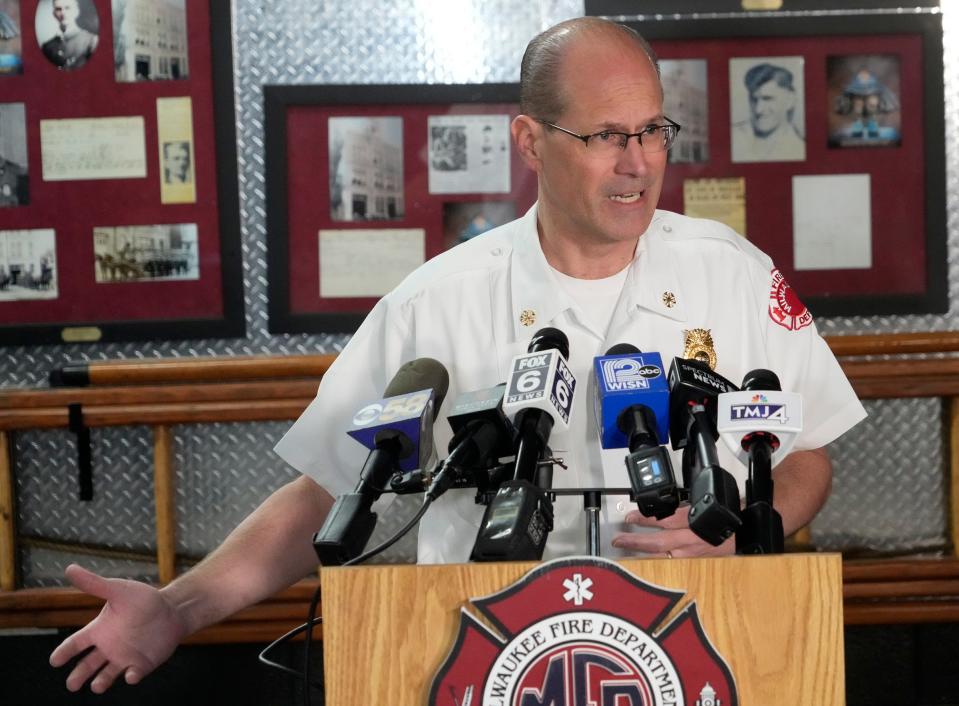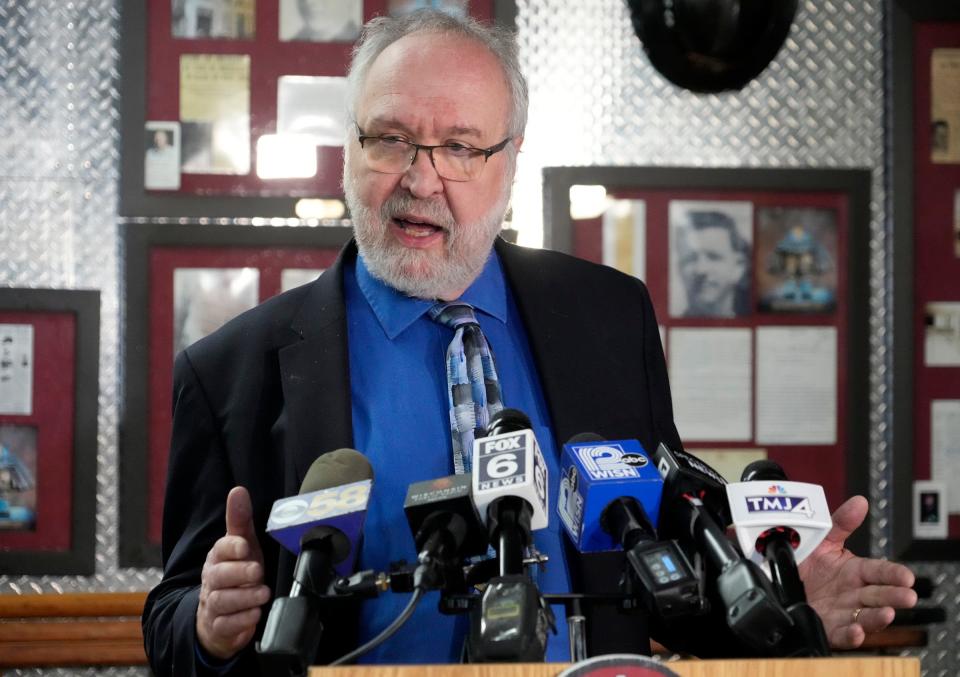Milwaukee fire chief says foot searches will be required after Jolene Waldref's death
For just over the last week, first responders with the Milwaukee Fire Department and the city’s two private ambulance companies have been expected to conduct foot searches any time a patient is not immediately located, Fire Chief Aaron Lipski told a city committee Thursday.
The chief called that a “stop-gap” measure while he and other emergency medical service officials scrambled to update standard operating guidelines after the death of Jolene Waldref at a busy intersection in subzero temperatures in January.
“We are reeling in the wake of this,” Lipski said in front of Milwaukee’s Public Safety and Health Committee. “We are feeling a tremendous amount of pressure to make this right.”
That pressure was turned up last week when the Milwaukee Common Council passed a resolution urging Lipski to make or examine a series of protocol changes meant to prevent the situation from happening again.
To emphasize the urgency, the council also delayed approval of an amendment to contracts with the city’s two private ambulance companies, which as a result has created a “cashflow issue” for those companies, one official said.
Although Lipski did not have a written draft of any protocol changes to share Thursday, he and officials from Bell Ambulance and Curtis Ambulance Service assured committee members they were on the same page and would satisfy the council’s desires. He said one of Waldref’s daughters has been involved in the process.
The nearly 90 minutes of dialogue was enough to convince the committee to recommend the full council approve the ambulance service contracts. The council next meets Feb. 27.
But Council President José Pérez made it clear that if the written changes were not satisfying, the contracts “will get held again.”
Here’s what you should know about the current state of things:
Waldref died despite ambulance responding to her location
Waldref, a 49-year-old mother of two from South Milwaukee, died Jan. 15 after calling 911 and reporting she couldn’t breathe as she waited near a bus stop at the busy intersection of North 76th and West Congress streets in subzero temperatures.
A Curtis Ambulance was dispatched but its crew did not see her lying on the ground near the intersection’s northwest corner. The crew eventually left the scene after driving through the intersection twice and not searching on foot, drawing backlash from the public and elected officials.
James Baker, the president of Curtis Ambulance, has since asserted that city dispatchers did not tell his ambulance crew that Waldref couldn’t breathe. That meant the ambulance crew – trained for basic life support – was dispatched thinking the call was not an emergency and did not have lights and sirens on.
Baker said Waldref’s call should have yielded a more urgent response.
Waldref ended up staying on the ground for more than 20 minutes until a driver stopped and called 911 again. That driver, Charlotte Morris of Milwaukee, said it was not hard to see Waldref.
The Milwaukee County Medical Examiner’s Office is investigating the death as a probable case of hypothermia. A final cause is pending results of a toxicology test.
Required foot searches expected as part of protocol changes

Fire and ambulance officials said that right now, all emergency medical service first responders have been told to use common sense and exit their vehicles when they arrive at a scene and cannot immediately see anyone in an emergency.
Lipski said that a formal update to their standard operating guidelines will instruct responders to conduct foot searches during extreme weather or when “environmental conditions or obstructions create impaired or reduced visibility at or around the location or landmark to which responders are dispatched.”
He said extreme weather conditions would include advisories and warnings for windchill, heat, winter storms, blizzards, ice storms, dense fog, air quality and snow squalls.
Responders will be instructed to interact with dispatch to re-establish contact with the caller, interact with bystanders in the area and activate lights and sirens to announce their arrival.
Other potential changes still taking shape
The resolution passed by the council last week urged Lipski to review "available and future technologies" for locating 911 callers who are using cellphones.
Lipski told the committee officials were not as far along on that and were still in an “analysis phase.”
He said one complicating factor is that the city’s dispatch service is scheduled to begin using a different computer aided dispatch software on Feb. 20 – the conclusion of a yearslong and bumpy effort by the city to switch software.
He added that officials are exploring how the new software could lead to quicker and easier information sharing with private ambulance companies.
The resolution also called for Lipski to review chances at enhancing the response for emergencies occurring outdoors in extreme weather events. Baker said previously that in years past, even low priority calls would result in a fire engine accompanying an ambulance to a scene if there was extreme weather.
That practice ended during the pandemic after concerns that it drained too many resources.
Thursday, Lipski said there are discussions about increasing the number of units that respond to patients who are outdoors in extreme weather, but they are still wary of the resource drain.
“We desperately want to avoid another tragedy, so striking that balance is going to be very important,” he said.
Lipski said there are few model policies that the council is asking for
Waldref’s death is unlike anything Lipski said he has ever seen before in his field. He joined the fire department in 1997.
He said he checked with others in the profession across the state and nation and “there are not many EMS providers that have a specific policy like this. It has just been assumed that when you get (to a scene) you do a thorough search.”
Alan DeYoung, the executive director of the Wisconsin EMS Association, told the Journal Sentinel in early February that protocols for searching for a patient generally aren't specific.
Officials apologize about the January press conference

The controversy around Waldref’s death was inflamed after a Jan. 30 press conference where officials not only admitted ambulance crews did not search on foot for Waldref, but Baker said no changes in protocol were necessary.
No other official, including those from the fire department, contradicted him.
Thursday, both Lipski and Baker apologized for how the press conference was handled and several times offered condolences to Waldref’s family and friends.
Lipski took responsibility for the “failed structuring” of the event.
“I will certainly, moving forward, work to ensure that action items for improvement are included when a system lapse has been identified,” he said. “The delay this will cause in the public release of information most definitely pales in comparison to doing this any other way.”
Baker later said, “I would also like to personally apologize for my performance at the press conference. I was looking at this in a very technical way and lost some of my compassion doing that.”
Contact Elliot Hughes at elliot.hughes@jrn.com or 414-704-8958. Follow him on X at @elliothughes12.
This article originally appeared on Milwaukee Journal Sentinel: Milwaukee fire chief: foot searches will soon be required

